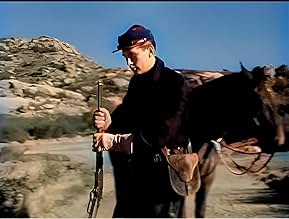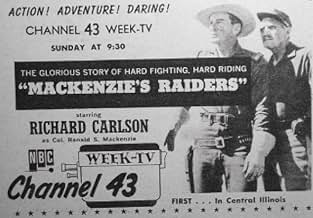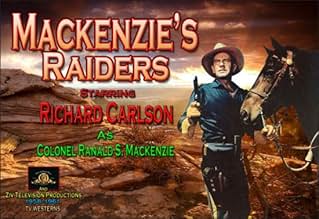CALIFICACIÓN DE IMDb
7.3/10
119
TU CALIFICACIÓN
Agrega una trama en tu idiomaCol. Mackenzie leads cavalry to prevent Mexican bandits from crossing Rio Grande on secret orders from President Grant and Secretary of War Belknap.Col. Mackenzie leads cavalry to prevent Mexican bandits from crossing Rio Grande on secret orders from President Grant and Secretary of War Belknap.Col. Mackenzie leads cavalry to prevent Mexican bandits from crossing Rio Grande on secret orders from President Grant and Secretary of War Belknap.
Explorar episodios
Opiniones destacadas
Finally!I have been trying to find info on this show for some time. I recalled it from the late 50s and reruns in the 60s probably because my father was in the 4th Cavalry,in the 1930's tho not in Texas,by then they were at Ft.Meade,S.D. but still mounted. Glad to see the info and that Richard Carlson was the Colonel,always did like him. I do recall a rather odd bit of uniform/costuming info unless I am confusing with another show.I remember the hats worn by the Raiders as having "plumes" or rather ostentatious feathers.Not a bit of US Cav kit I ever recall as proper but more reminiscent of Confederate Cavalry.The show ran late nights for quite some time in our broadcast area in syndication.
I remember watching this with a little friend of mine from nursery school. We were 4 or 5 years old, but already experienced in running around pretending to shoot at each other and imaginary Indians and bad guys. (I was already fairly sympathetic to Indians in westerns, thanks to my Mom, who had explained some basic history to us). I liked the theme music, too.... I have only given it a 7 out of 10 rating, since I think it was probably not distinguished by great stories or extraordinary acting, but as a young fan, I was a devoted follower, and was crushed when it was canceled. It would be nice to see it on Nick or TVLand, or on DVD, but it's probably not in the cards, alas.
During the 1950s there were a plethora of television series produced that were based upon characters from the "Old West". Unlike many other examples of that genre, however, the central figure in "Mackenzie's Raiders", was not only a real character but, if anything, the real character was far more interesting than his screen portrayal. There really was a Ranald (sic) Mackenzie and his real Army career was, if anything, UNDERSTATED in this television representation. John Ford's well known film, "The Man Who Shot Liberty Valance", included the famous line, "When the legend becomes fact, print the legend." However, in the case of Ronald Mackenzie, the facts were far more remarkable than anything depicted in the television series.
Described by General Ulysses S. Grant as "The most promising young officer in the Army", the REAL Ranald Mackenzie was a Corps Commander in the Union Army at the age of only 24 years. Wounded six times during the Civil War (including the loss of part of his right hand, for which the Native Americans dubbed him, "Bad Hand"), Mackenzie spent the next 18 years after the end of that conflict on active service in the West, much of it in action of one sort or another. In fact, taking into account both his service in the Civil War and in the West, It has been alleged that MacKenzie spent more of his Army carrier in actual combat than any other soldier in U.S. history. Incidentally, note that actor Richard Carlson clearly depicted Mackenzie with all five fingers on his right hand. which indicated that Carlson's depiction of Mackenzie was clearly inaccurate even from that aspect alone.
Unlike the far better remembered George Custer, Mackenzie did NOT lead his troops into disaster. Quite the contrary, Mackenzie was a very successful military commander. So, why is Mackenzie so little remembered today? The reason probably lies in the fact that, during the last five years of his relatively brief life, Mackenzie descended into a state of madness. His condition became so bad that the Army had to retire him from active service, and he spent the last five years of his life in and out of insane asylums. Looking back over the extraordinary carrier of this remarkable soldier, one cannot help speculating that he might well have been suffering from a form of what we now call "post-traumatic stress disorder", a term that did to exist in the 19th century, and that the medical profession of the day knew nothing whatever about.
Described by General Ulysses S. Grant as "The most promising young officer in the Army", the REAL Ranald Mackenzie was a Corps Commander in the Union Army at the age of only 24 years. Wounded six times during the Civil War (including the loss of part of his right hand, for which the Native Americans dubbed him, "Bad Hand"), Mackenzie spent the next 18 years after the end of that conflict on active service in the West, much of it in action of one sort or another. In fact, taking into account both his service in the Civil War and in the West, It has been alleged that MacKenzie spent more of his Army carrier in actual combat than any other soldier in U.S. history. Incidentally, note that actor Richard Carlson clearly depicted Mackenzie with all five fingers on his right hand. which indicated that Carlson's depiction of Mackenzie was clearly inaccurate even from that aspect alone.
Unlike the far better remembered George Custer, Mackenzie did NOT lead his troops into disaster. Quite the contrary, Mackenzie was a very successful military commander. So, why is Mackenzie so little remembered today? The reason probably lies in the fact that, during the last five years of his relatively brief life, Mackenzie descended into a state of madness. His condition became so bad that the Army had to retire him from active service, and he spent the last five years of his life in and out of insane asylums. Looking back over the extraordinary carrier of this remarkable soldier, one cannot help speculating that he might well have been suffering from a form of what we now call "post-traumatic stress disorder", a term that did to exist in the 19th century, and that the medical profession of the day knew nothing whatever about.
General Ranald Slidell Mackenzie was indeed a real historical figure. His tragic end, in which he descended into madness, has obscured his outstanding record of achievement. While I remember this show from when I was a boy, it did not do justice to the real man. Mackenzie brought peace to the southern plains, accomplishing in a few short years what Texans had tried to achieve for three generations. While commanders like Custer, George Crook, and Nelson Miles are better remembered today, Mackenzie and his crack regiment, the 4th Cavalry, deserve to be remembered and at least equally well known. Not only did Mackenzie stop the predatory raiding of the Comanches, he dealt with them equitably in peacetime. He was most proud of having stopped wars without spilling blood. He deserves better than to remain obscure.
I didn't care for it but i bought it for the guest stars. Blood in the rio ep had John Milford who is just a gorgeous hunk of man flesh. Pistol whipped ep had Charles Maxwell, another gorgeous goon, Jack Elam who is wonderful was in an ep. However i must complain - Nimoy & Jaffe are not Indians!
¿Sabías que…?
- TriviaDuring the American Civil War, in June of 1864, then Second Lieutenant Ranald Mackenzie was wounded at the Battle of Jerusalem Plank Road (also know as the First Battle of Weldon Railroad). He lost two fingers on his right hand. This earned him the nickname of "Bad Hand Mackenzie".
Selecciones populares
Inicia sesión para calificar y agrega a la lista de videos para obtener recomendaciones personalizadas
Detalles
- Fecha de lanzamiento
- País de origen
- Idioma
- También se conoce como
- Mackenzie's Raiders
- Locaciones de filmación
- Productora
- Ver más créditos de la compañía en IMDbPro
- Tiempo de ejecución30 minutos
- Color
- Relación de aspecto
- 1.33 : 1
Contribuir a esta página
Sugiere una edición o agrega el contenido que falta

Principales brechas de datos
By what name was Los jinetes de Mackenzie (1958) officially released in Canada in English?
Responda


































